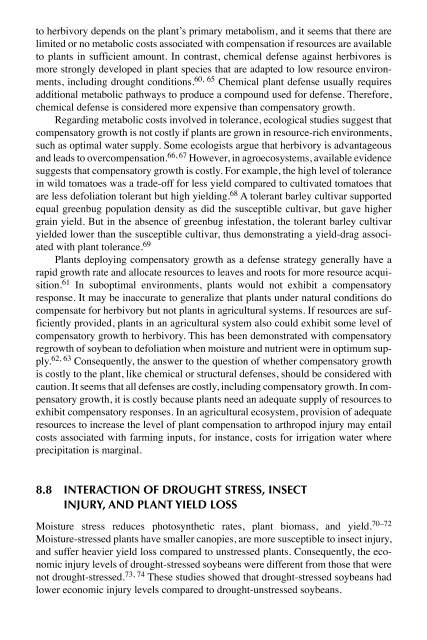Biotic Stress and Yield Loss
Biotic Stress and Yield Loss
Biotic Stress and Yield Loss
- No tags were found...
You also want an ePaper? Increase the reach of your titles
YUMPU automatically turns print PDFs into web optimized ePapers that Google loves.
to herbivory depends on the plant’s primary metabolism, <strong>and</strong> it seems that there arelimited or no metabolic costs associated with compensation if resources are availableto plants in sufficient amount. In contrast, chemical defense against herbivores ismore strongly developed in plant species that are adapted to low resource environments,including drought conditions. 60, 65 Chemical plant defense usually requiresadditional metabolic pathways to produce a compound used for defense. Therefore,chemical defense is considered more expensive than compensatory growth.Regarding metabolic costs involved in tolerance, ecological studies suggest thatcompensatory growth is not costly if plants are grown in resource-rich environments,such as optimal water supply. Some ecologists argue that herbivory is advantageous<strong>and</strong> leads to overcompensation. 66, 67 However, in agroecosystems, available evidencesuggests that compensatory growth is costly. For example, the high level of tolerancein wild tomatoes was a trade-off for less yield compared to cultivated tomatoes thatare less defoliation tolerant but high yielding. 68 A tolerant barley cultivar supportedequal greenbug population density as did the susceptible cultivar, but gave highergrain yield. But in the absence of greenbug infestation, the tolerant barley cultivaryielded lower than the susceptible cultivar, thus demonstrating a yield-drag associatedwith plant tolerance. 69Plants deploying compensatory growth as a defense strategy generally have arapid growth rate <strong>and</strong> allocate resources to leaves <strong>and</strong> roots for more resource acquisition.61 In suboptimal environments, plants would not exhibit a compensatoryresponse. It may be inaccurate to generalize that plants under natural conditions docompensate for herbivory but not plants in agricultural systems. If resources are sufficientlyprovided, plants in an agricultural system also could exhibit some level ofcompensatory growth to herbivory. This has been demonstrated with compensatoryregrowth of soybean to defoliation when moisture <strong>and</strong> nutrient were in optimum supply.62, 63 Consequently, the answer to the question of whether compensatory growthis costly to the plant, like chemical or structural defenses, should be considered withcaution. It seems that all defenses are costly, including compensatory growth. In compensatorygrowth, it is costly because plants need an adequate supply of resources toexhibit compensatory responses. In an agricultural ecosystem, provision of adequateresources to increase the level of plant compensation to arthropod injury may entailcosts associated with farming inputs, for instance, costs for irrigation water whereprecipitation is marginal.8.8 INTERACTION OF DROUGHT STRESS, INSECTINJURY, AND PLANT YIELD LOSSMoisture stress reduces photosynthetic rates, plant biomass, <strong>and</strong> yield. 70–72Moisture-stressed plants have smaller canopies, are more susceptible to insect injury,<strong>and</strong> suffer heavier yield loss compared to unstressed plants. Consequently, the economicinjury levels of drought-stressed soybeans were different from those that werenot drought-stressed. 73, 74 These studies showed that drought-stressed soybeans hadlower economic injury levels compared to drought-unstressed soybeans.

















